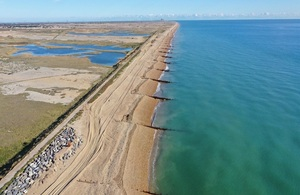The Lydd Ranges Sea Defences scheme has been completed and was officially opened in July 2024 at an opening event held by the Environment Agency with construction partner Van Oord UK Ltd at Lydd Community Hall. The Environment Agency worked closely with Natural England and the Ministry of Defence (MoD) to plan the scheme and ensure the environmental designations remained protected.
The scheme is part of the Folkestone to Cliff End Strategy (FoCES), approved by government in 2010. It sets out the Environment Agency’s plans to manage flood and erosion risks along the Romney Marsh coastline over the next 100 years, taking the predicted impacts of climate change into account.
Aerial photo of Lydd Ranges in Kent.
A major flood risk
With much of Romney Marsh below high tide level, 14,500 homes, 700 businesses as well as nationally important, critical infrastructure are at risk of flooding. Lydd’s sea frontage is vulnerable to erosion and has suffered from the effects of recent storms Dennis and Ciara, particularly at Jury’s Gap.
Now completed, this scheme will help better protect this environmentally important area; the Ministry of Defence (MoD) firing range; and people, property and businesses from flooding.
Key elements of the scheme include:
- Importing over 390,000 tonnes of shingle from a licenced marine source to replenish the beach.
- Crushing of the concrete from the old MoD access track and using it as a sub-base for the new roadway to minimise waste and the volume of new material needed.
- Improving the MoD’s 1.8-kilometre-long concrete track and flood wall, known as the Green Wall.
Sally Harvey, Environment Agency Area Director said: “The completion of the Lydd Ranges Scheme is a significant milestone in our continued efforts to enhance coastal flood protection and secure the Romney and Walland Marsh areas under the Folkestone to Cliff End Coastal Strategy (FoCES).
I am proud of what has been achieved in carbon saving innovation and would like to thank our partners for their enthusiasm in adopting new techniques to reduce CO2 emissions. Using materials such as biofuels and cement-free concrete, recycled and sustainably sourced timber and solar power on site.
Our stakeholders, the Ministry of Defence and Natural England, in collaboration with ourselves, Van Oord and Mackley, and many others, have brought expertise and commitment to every phase of the project. Their contributions to the scheme were vital to help overcome challenges and achieve the success that will benefit local communities, the environment, and the MoD ranges for years to come.”
Read the full press release here
To find out more on how the scheme was delivered, you can watch the Lydd Ranges Sea Defence scheme video explaining how this vital project was completed.
